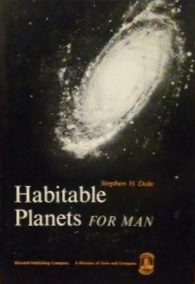Habitable Planets for Man

Habitable Planets For Man is a work by Stephen Dole, first edition published by Blaisdell Publishing Company, A division of Ginn and Company, copyright 1964 by The RAND Corporation. Originally 158 pages, it was republished in a posthumous second edition in 2007, as Planets for Man.[1]
The revised edition, 174 pages, contains a detailed scientific study on the nature of worlds that may support life in the universe, the probability of their existence, and ways of finding them.[2][3] It includes assessments of 14 stars within 22 light years with a relatively high probability of having habitable planets (a collective probability of 43%).[4][5] Writing in a Scientific American blog in 2011, Caleb Scharf called it "extraordinarily detailed and prescient".[2]
Publication data
External links
References
- ^ Stephen H. Dole (1970). Habitable Planets for Man (2nd ed.). New York: American Elsevier.
- ^ a b Caleb A. Scharf (September 13, 2011). "The Habitable Planets". Life Unbounded, Scientific American.
- ^ "Planet Life". Science Notes, The New York Times. July 12, 1964.
- ^ William C. Saslaw (December 1964). "Review: Habitable Planets for Man by Stephen H. Dole". American Scientist. 52 (4): 466A–477A. JSTOR 27839216.
- ^ Joe W. Tyson (June 1965). "Review: Habitable Planets for Man by Stephen H. Dole". The Quarterly Review of Biology. 40 (2): 229. doi:10.1086/404644. JSTOR 2819795.
